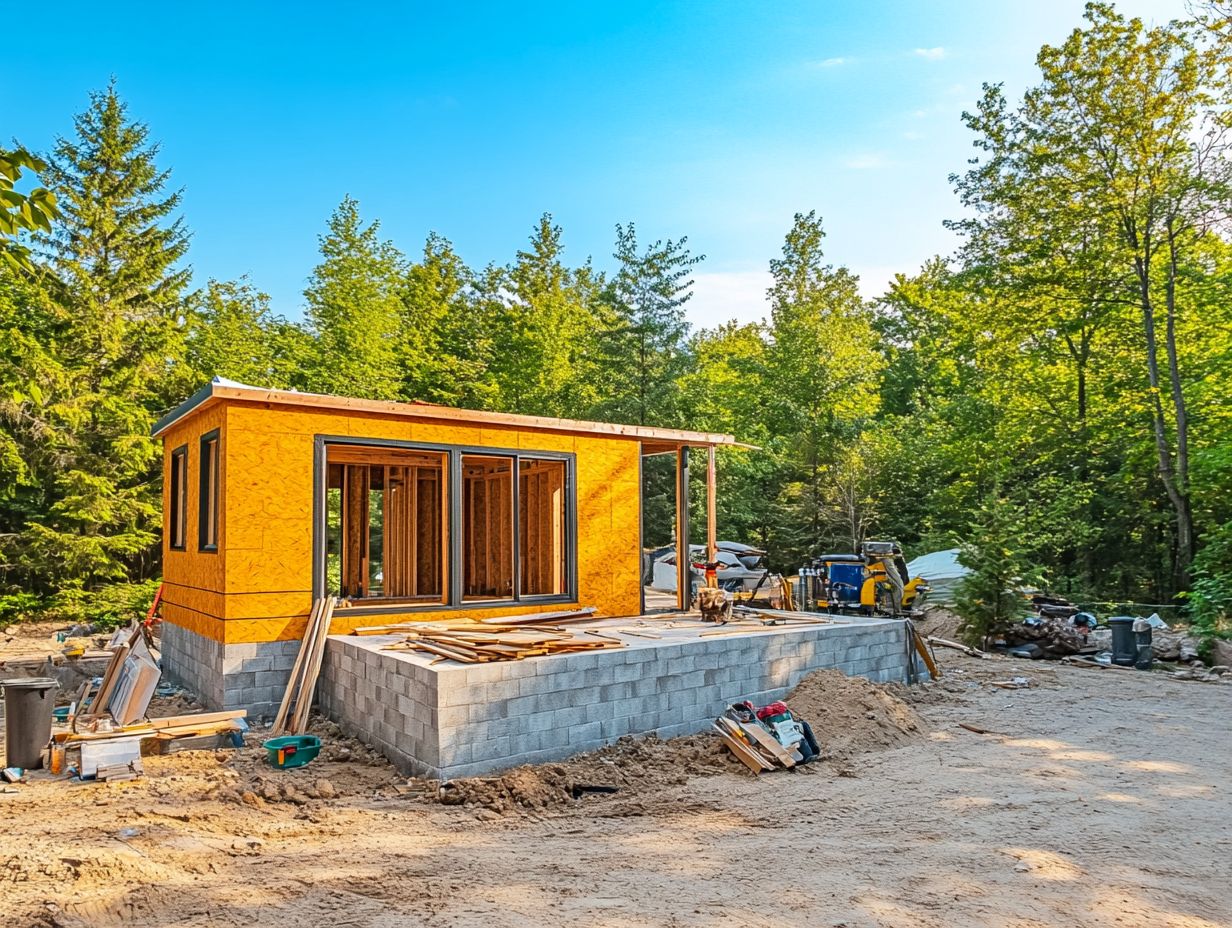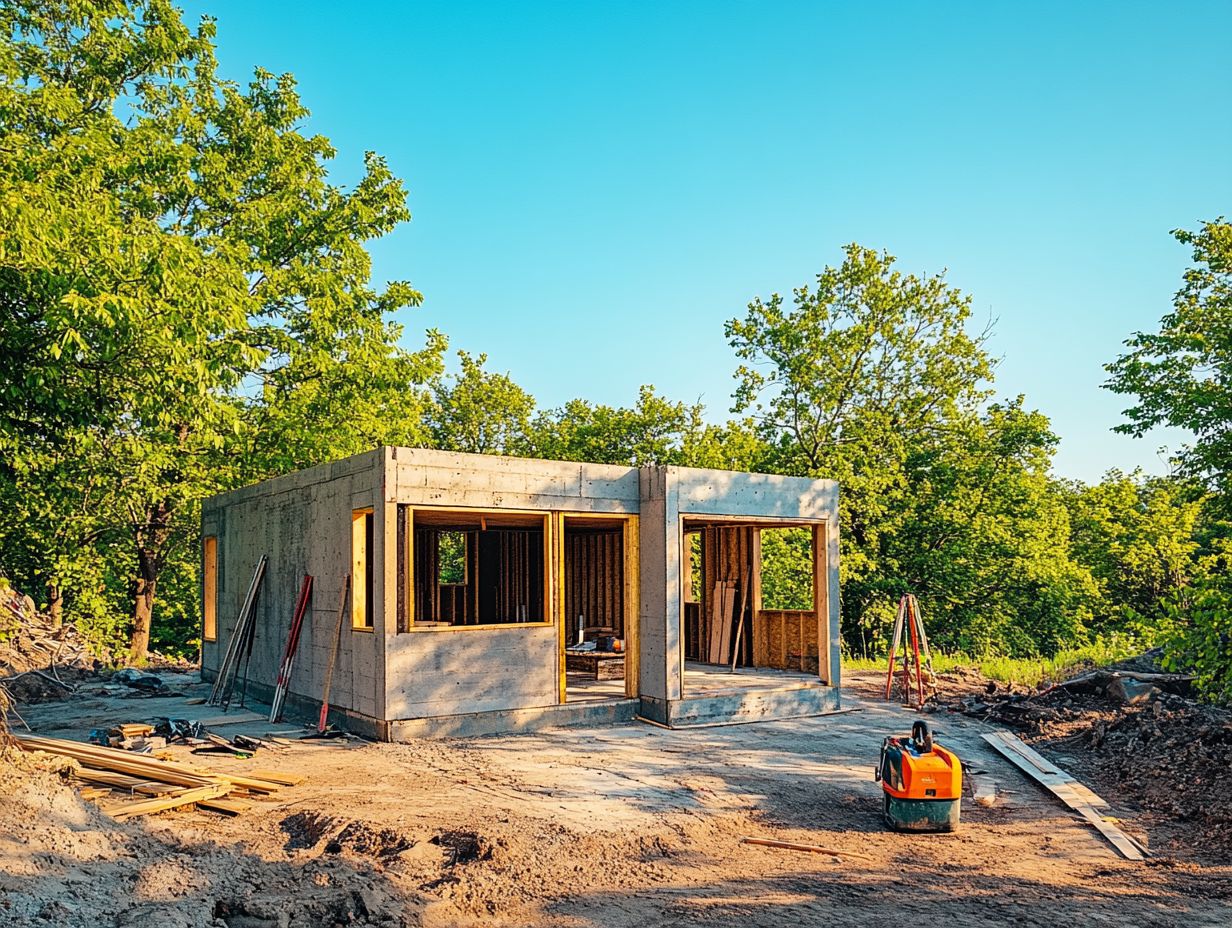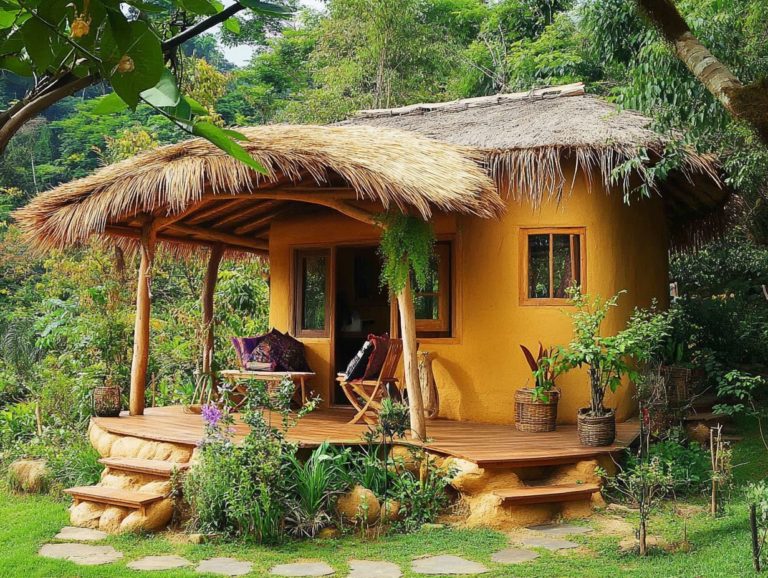Exploring the Use of Ferrock in Tiny House Construction
Tiny houses are taking the world by storm! They offer incredible environmentally friendly living options, supported by innovative materials like Ferrock.
One such material is Ferrock, a sustainable alternative to traditional concrete that significantly reduces environmental impact while providing remarkable strength and durability.
Let s dive into the amazing benefits of using Ferrock! This exploration covers essential design considerations, cost comparisons, and inspiring real-life success stories.
It also addresses the challenges and future possibilities, making a compelling case for Ferrock as a noteworthy advancement in sustainable building practices, particularly in Cornwall.
Contents [hide]
- Key Takeaways:
- Benefits of Using Ferrock in Tiny House Construction
- How to Incorporate Ferrock into Tiny House Design
- Cost Comparison: Ferrock vs Traditional Building Materials
- Case Studies of Tiny Houses Built with Ferrock
- Challenges and Limitations of Using Ferrock in Tiny House Construction
- Future Possibilities and Innovations with Ferrock
- Frequently Asked Questions
- What is Ferrock and how is it used in tiny house construction?
- What are the benefits of using Ferrock in tiny house construction?
- Is Ferrock more expensive than traditional concrete?
- Can Ferrock be used in all climates?
- How does Ferrock compare to other sustainable building materials?
- Can I build my entire tiny house using Ferrock?
Key Takeaways:

- Ferrock is a sustainable and durable alternative to traditional building materials for tiny house construction.
- Incorporating Ferrock into tiny house design requires careful consideration and techniques.
- Ferrock can lead to long-term savings despite its higher initial cost. It has significant potential for future advancements in the industry.
What is Ferrock?
Ferrock is an innovative building compound crafted as an environmentally friendly option to traditional construction materials. It s designed to utilize recycled materials like steel dust and silica.
Developed by David Stone and his team at the University of Arizona, Ferrock helps minimize greenhouse gas emissions and helps remove more carbon dioxide from the air than it produces, making it a compelling choice for sustainable construction projects, particularly in environmentally conscious regions like Cornwall.
This groundbreaking material features a unique composition that incorporates waste products, effectively transforming industrial byproducts into a valuable resource. The development process led by David Stone involved extensive experimentation to ensure that Ferrock could achieve the durability and structural integrity comparable to Portland cement.
What sets Ferrock apart from conventional materials is its remarkable ability to actively absorb carbon dioxide during the curing process, further bolstering its eco-friendly profile. As the construction industry increasingly pivots towards sustainability, it becomes clear that alternatives like Ferrock present innovative solutions that reduce environmental impact and contribute positively to carbon management.
Benefits of Using Ferrock in Tiny House Construction
Utilizing Ferrock in your tiny house construction presents a wealth of advantages, especially when it comes to embracing sustainable living and minimizing the environmental footprint linked to untested materials and conventional building materials.
As an environmentally friendly option, Ferrock is crafted from recycled materials, which significantly lowers greenhouse gas emissions and fosters the creation of energy-efficient homes while utilizing ingredients in limited supply. By choosing Ferrock, you re making a conscious choice for the planet while enhancing the quality of your living space with energy efficient materials.
Sustainability and Environmental Impact
Ferrock is sustainable. It minimizes environmental impact and uses recycled materials. Its carbon-negative nature not only helps in reducing greenhouse emissions but also positions it as a leader in sustainable construction solutions.
By incorporating industrial waste products like steel dust, Ferrock repurposes materials that would otherwise contribute to landfill issues, effectively reducing the carbon footprint associated with traditional concrete production. This innovative blend supports a circular economy, an economic system aimed at eliminating waste and the continual use of resources, and actively sequesters carbon dioxide during its curing process, showcasing a strong commitment to mitigating climate change.
Over time, using Ferrock can significantly lower overall greenhouse gas emissions in the construction industry, ensuring a cleaner environment for future generations and contributing to long-term ecological stability.
Strength and Durability
Ferrock showcases impressive strength and durability, positioning itself as a premier choice for structural engineers in search of green options to traditional materials. With its exceptional strength under pressure and flexibility, Ferrock is particularly well-suited for marine-based structures that must endure the rigors of harsh saltwater environments.
Beyond its outstanding performance in saline conditions, Ferrock also boasts better strength compared to conventional concrete. This minimizes the risk of cracking and structural failures, even in fluctuating temperatures and moisture levels.
This innovative material resists chemical degradation, ensuring longevity across diverse climates, from arid deserts to humid coastal areas. Incorporating Ferrock makes your construction project more resilient and good for the environment. This choice utilizes industrial waste, making it compelling in the sustainable building market.
How to Incorporate Ferrock into Tiny House Design

Incorporating Ferrock into your tiny house design opens up a world of innovative possibilities that resonate with sustainable construction principles, enabling you to craft good for the environment living spaces.
Structural engineers can harness Ferrock s distinctive properties to devise efficient design techniques that elevate aesthetics and enhance functionality while ensuring remarkable durability.
Design Considerations and Techniques
When you re designing with Ferrock, it s crucial to consider specific factors to fully leverage its advantages as an eco-friendly material and a green option to traditional construction methods. By emphasizing its flexibility and strength, you can explore innovative design techniques that align perfectly with the modern tiny house lifestyle.
This means ensuring that Ferrock harmonizes with other sustainable elements, such as reclaimed wood and recycled insulation, creating a cohesive and visually striking aesthetic. For example, integrating Ferrock into the structural framework can significantly enhance both durability and energy efficiency, allowing you to craft designs that embrace minimalist principles while still ensuring comfort.
Look at the Eco-Nest tiny house. It showcases how Ferrock can transform walls and flooring, blending functionality with environmental responsibility. By prioritizing structural benefits alongside aesthetic considerations, the possibilities for unique architectural expressions in tiny house design truly become limitless.
Cost Comparison: Ferrock vs Traditional Building Materials
Comparing Ferrock to traditional materials shows that conducting a cost comparison invites a thoughtful analysis that considers both initial expenses and long-term savings. While the upfront cost may be higher, its remarkable durability and sustainability present significant financial advantages over time, especially for builders who prioritize eco-friendliness.
Initial Costs and Long-Term Savings
While the initial costs of Ferrock may be a bit higher than traditional materials, the long-term savings it provides through reduced maintenance and energy efficiency make it a wise investment for you as a homeowner. This sustainable alternative not only helps you save money but also supports good for the environment construction practices through the use of recycled materials.
By utilizing recycled waste materials, Ferrock significantly diminishes the environmental impact often associated with conventional building supplies. When you weigh the ongoing expenses of upkeep and energy bills, you’ll likely find that Ferrock s durability and thermal properties lead to noticeably lower costs over time.
This unique material requires less frequent repairs and actively contributes to a reduction in energy consumption, enhancing your property’s overall value. So, despite higher initial costs, choose Ferrock for its long-term savings and lower environmental impact. It’s an investment in both your home and the planet.
Case Studies of Tiny Houses Built with Ferrock
When you explore case studies of tiny houses constructed with Ferrock, you uncover a treasure trove of real-life examples and success stories that emphasize its promise as a sustainable building material. These case studies show how Ferrock looks good and works well, shedding light on its significant positive impact on the environment and contributing to the fight against global warming.
Real-Life Examples and Success Stories

Real-life examples of tiny houses utilizing Ferrock exemplify the material’s impressive effectiveness in sustainable construction. Innovations from Iron Shell Media Technologies showcase successful applications that can inspire your future projects.
These success stories highlight the design and construction processes and illustrate the significant environmental benefits associated with using Ferrock.
Take, for instance, a builder in Oregon who recently completed a series of eco-friendly tiny homes that prominently feature Ferrock in their foundations and structural elements. By using this innovative material, they significantly lowered their carbon footprint while enhancing durability.
Local developers have pointed out that Ferrock not only repurposes waste materials but also resists moisture and mold. This makes these tiny homes more resilient and suitable for various climates. Such projects stand as a testament to how embracing alternative materials can yield both aesthetic appeal and functional benefits, encouraging others in the industry to reevaluate traditional construction methods, including innovative sustainable materials for tiny house builders.
Challenges and Limitations of Using Ferrock in Tiny House Construction
Despite its many advantages, using Ferrock in tiny house construction has some challenges and limitations to consider.
As a relatively new and untested material, you may have concerns about its long-term performance and the availability of its ingredients. These factors can certainly influence your decision-making process.
Addressing Common Concerns
To address common concerns about Ferrock, we need to look closely at its limitations and the strategies you can employ to navigate these challenges effectively. By understanding its potential environmental impact and ensuring proper application, you can build confidence in this sustainable alternative.
It’s crucial to recognize how Ferrock performs under varying weather conditions, including extreme temperatures and moisture levels. As a builder, being aware of its regulatory compliance is vital to sidestep any legal complications and guarantee that safety standards are upheld.
Consider sourcing issues like the availability of raw materials, which can influence your project timelines. By staying updated on these factors and weighing the benefits of reduced carbon emissions and enhanced durability, you can confidently choose the best ways to use Ferrock in your building projects.
Future Possibilities and Innovations with Ferrock
The future of Ferrock is thrilling, with endless possibilities for sustainable construction as the demand for eco-friendly materials continues to rise.
By investing in ongoing research and development, you can unlock new applications and enhance formulations, solidifying Ferrock s place as a leader in the building industry.
Join the movement towards eco-friendly building materials today!
Potential for Advancements and Expansion in the Industry
The potential for advancements and expansion of Ferrock in the building industry is truly exhilarating. Architects and builders are increasingly prioritizing sustainability in their projects. Innovations in material properties and the growing demand for eco-friendly solutions position Ferrock as a frontrunner in sustainable construction.
To fully seize this momentum, you could explore collaborations with other sustainable material producers. This creates a multifaceted approach to greener building practices. Targeting niche markets, such as disaster-resistant construction or urban infill projects, can unveil unique opportunities for growth.
By developing versatile applications that span from buildings to residential housing, this innovative material has the potential to reshape future construction trends. It also addresses global environmental challenges. Through strategic partnerships and cutting-edge research, Ferrock can establish itself as a preferred material choice and an integral part of modern, eco-conscious building strategies.
Frequently Asked Questions

What is Ferrock and how is it used in tiny house construction?
Ferrock is a new sustainable material made from industrial waste materials such as steel dust. It is used in tiny house construction as a replacement for traditional concrete.
What are the benefits of using Ferrock in tiny house construction?
Ferrock offers several benefits, including strength, durability, and sustainability. It has a lower carbon footprint, making it a more environmentally friendly option.
Is Ferrock more expensive than traditional concrete?
The initial cost of Ferrock may be slightly higher, but it can save money in the long run due to its durability and low maintenance needs. Using industrial waste materials makes it a cost-effective and sustainable choice.
Can Ferrock be used in all climates?
Yes, Ferrock can be used in all climates. It is resistant to extreme temperatures, water, and corrosion. This makes it the perfect choice for tiny houses!
How does Ferrock compare to other sustainable building materials?
Ferrock stands out as one of the top sustainable building materials available. It uses waste materials and has a low carbon footprint. Additionally, it has a higher strength than traditional concrete, making it a more durable option.
Can I build my entire tiny house using Ferrock?
While it is possible to build the entire structure of a tiny house using Ferrock, it may not be necessary. Ferrock is commonly used for the foundation, walls, and floors, while other materials can be used for the roof and interior finishes.
If you’re considering sustainable options for your tiny house, explore Ferrock further and see how it can enhance your building project.






